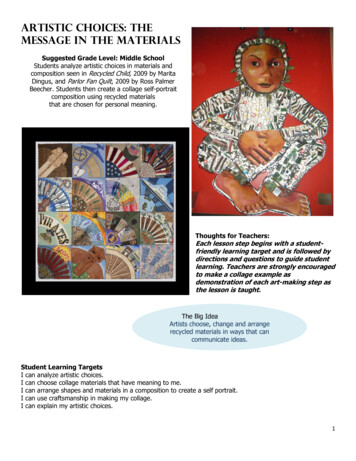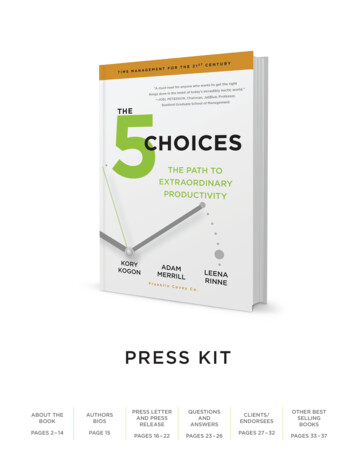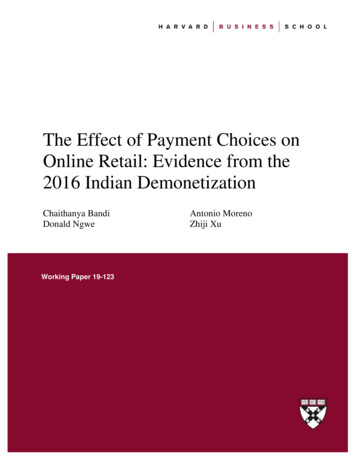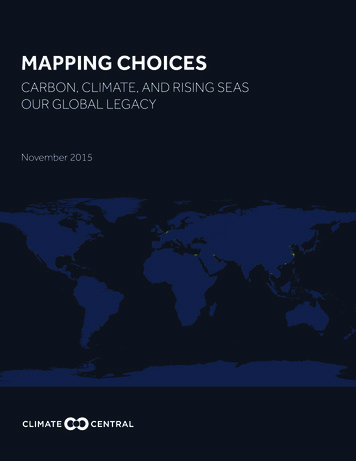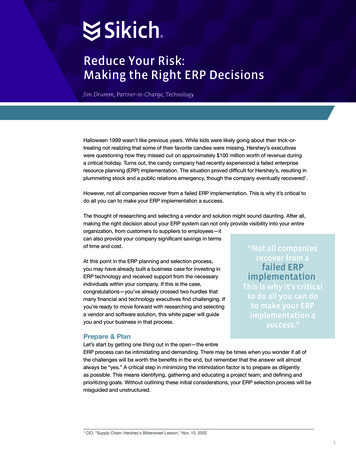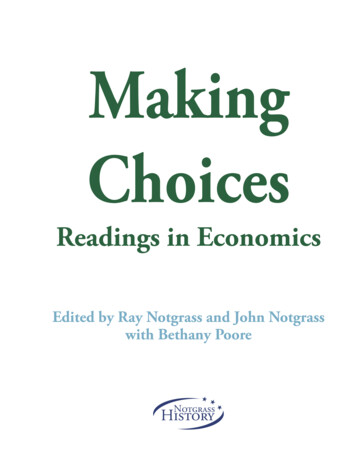
Transcription
MakingChoicesReadings in EconomicsEdited by Ray Notgrass and John Notgrasswith Bethany PooreNotgrassHistory
Making ChoicesEdited by Ray Notgrass and John Notgrasswith Bethany PooreISBN 978-1-60999-095-4Except where noted, the documents in this collection are in the public domain.Editorial comments and design are copyright 2016 Notgrass Company.All rights reserved.All product names, brands, and other trademarks mentioned or picturedin this book are used for educational purposes only.No association with or endorsement by the owners of the trademarks is intended.Each trademark remains the property of its respective owner.Cover and interior design by Mary Evelyn McCurdyPrinted in the United States of AmericaNotgrass Company975 Roaring River RoadGainesboro, TN 385621-800-211-8793www.notgrass.com
Table of ContentsIntroduction iii“I, Pencil” by Leonard Read (1958).1The Wealth of Nations (excerpt) by Adam Smith (1776).7“Socialism, Capitalism, and the Bible” by Ronald H. Nash (1985).16Precepts of Ptah-Hotep (Egyptian, c. 2000 bc).23“A Model of Christian Charity” (excerpt) by John Winthrop (1630).25“The Use of Money” (excerpt) by John Wesley (1744).26Letter 4 of the Letters from a Farmer in Pennsylvania by John Dickinson (1768).34Letters to John P. Nicholson by Sam Watkins (1882).37“Free to Choose: A Conversation with Milton Friedman” (2006).39Letter to Eli Whitney Sr. by Eli Whitney Jr. (1793).48Letter to Eli Whitney Jr. by Thomas Jefferson (1793).51Letters to Theodore and Martha Roosevelt by Theodore Roosevelt Jr. (1876-1878).52“The Market and Human Values” by John Davenport (1975).55Interview with Soviet Refugeeby the Harvard Project on the Soviet Social System (1950s).62Principles of Economics (excerpt) by Alfred Marshall (1890).66“Finance and Society” by Janet Yellen (2015).72“The Candlemakers’ Petition” by Frederic Bastiat (1845).78U.S. Customs and Border Protection (2016).82“Market Entrepreneurs: Building Empires of Service” by Burton W. Folsom Jr. (1997).85“What Makes for Success?” by Kemmons Wilson (1997).94“Lilian’s Business Venture” by Lucy Maud Montgomery (1900).98Mind Amongst the Spindles (excerpt) by Harriet Martineau (1844).102“Labor Unions in a Free Market” by Ernest van den Haag (1979).106My Life and Work (excerpt) by Henry Ford (1922).116Random Reminiscences of Men and Events (excerpt) by John D. Rockefeller (1909).120i
Program for Economic Recovery by Ronald Reagan (1981).123“The Legitimate Role of Government in a Free Society” by Walter E. Williams (2000).133US Foods IPO by Intercontinental Exchange (2016).139“Poverty and Wealth” by Ella Wheeler Wilcox (c. 1883).141“Will We Heal with Living Water or Snake Oil?” by Eric Potter (2016).142“Security in Your Old Age” by Social Security Board (1936).146“How Detroit’s Automakers Went from Kings of the Road to Roadkill”by Joseph B. White (2009).149“Ecology and the Economy: The Problems of Coexistence”by James L. Buckley (1980).158“The Rules of the Game and Economic Recovery” by Amity Shlaes (2010).170Speech on the Economic Bailout Proposal by George W. Bush (2008).177“What Makes for Success?” by Dave Thomas (1996).182“The Art of Money Getting” by P. T. Barnum (1880).196“The Wanamaker Name” by Philip Ryken (1995).204Image Credits.208ii
IntroductionMaking Choices is a compilation of historic documents, speeches, essays, and otherwritings, all of which further our understanding of economics. We created it for studentsto use in conjunction with the text Exploring Economics. The student who is using that textwill find these readings assigned at the end of the appropriate lessons.The order of the documents reflects the order in which they are assigned in ExploringEconomics. The purpose of this collection is to give the reader handy access to significantoriginal documents and to highlight the experience, opinions, and ideas of others so thatthe reader can develop his or her own informed thinking about economics. We have usedexcerpts of some documents, indicated by ellipses.You might not agree with all of the opinions presented in this collection. The sameis true for us. Notgrass History does not endorse every person or idea included in thisvolume. The authors of these readings, as do all people, have differing opinions abouteconomics, the way people should use money, appropriate decisions in business, andmany other topics. It is a good exercise to read material that challenges your thinking andhelps you clarify what you believe, even if you do not agree with the author. Sometimesyou may come to realize that your outlook and opinions need to change.Economics is not merely a group of theories and numbers, stuck on paper or lockedin big bank buildings. Economics happens when you (and people across the globe) earnmoney, give to a church and charities, choose where to shop and what to buy, preparefor a career, save and invest money, run a business, comply with government rules,pay taxes—in other words, when you are living life. Understanding economics is wellworth your time. You will benefit yourself, your future family, and the local and globaleconomy. Most importantly, you will be a better steward of God’s resources that He hasentrusted to your care.Ray Notgrassiii
I, PencilLeonard Read (1958)Leonard Read (1898-1983) established the Foundation for Economic Education in 1946 (www.fee.org).This organization promotes individual liberty, free markets, and property rights. Read wrote this essay in1958. The Imprimis introduction to the essay invites the reader to “Wonder at the countless bits of humanknow-how and natural materials spontaneously organized by our global market economy into the makingof a simple wooden pencil. . . . And wonder, most of all, at the everyday miracles made possible by a politicaland economic system that dares to have faith in free men.”I am a lead pencil—the ordinary wooden pencil familiar to all boys and girls andadults who can read and write. (My official name is “Mongol 482.” My many ingredientsare assembled, fabricated, and finished by Eberhard Faber Pencil Company, WilkesBarre, Pennsylvania.)Writing is both my vocation and my avocation; that’s all I do.You may wonder why I should write a genealogy. Well, to begin with, my story isinteresting. And, next, I am a mystery—more so than a tree or a sunset or even a flashof lightning. But, sadly, I am taken for granted by those who use me, as if I were a mereincident and without background. This supercilious attitude relegates me to the level ofthe commonplace. This is a species of the grievous error in which mankind cannot toolong persist without peril. For, as a wise man observed, “We are perishing for want ofwonder, not for want of wonders” (Chesterton).I, Pencil, simple though I appear to be, merit your wonder and awe, a claim I shallattempt to prove. In fact, if you can understand me—no, that’s too much to ask of anyone—if you can become aware of the miraculousness which I symbolize, you can help save thefreedom mankind is so unhappily losing. I have a profound lesson to teach. And I canteach this lesson better than can an automobile or an airplane or a mechanical dishwasherbecause—well, because I am seemingly so simple.Simple? Yet, not a single person on the face of this earth knows how to make me. Thissounds fantastic, doesn’t it? Especially when it is realized that there are about one andone-half billion of my kind produced in the U.S.A. each year.Pick me up and look me over. What do you see? Not much meets the eye—there’ssome wood, lacquer, the printed labeling, graphite lead, a bit of metal, and an eraser.Innumerable AntecedentsJust as you cannot trace your family tree back very far, so is it impossible for me toname and explain all my antecedents. But I would like to suggest enough of them toimpress upon you the richness and complexity of my background.1
My family tree begins with what in fact is a tree, a cedar of straight grain that growsin Northern California and Oregon. Now contemplate all the saws and trucks and ropeand the countless other gear used in harvesting and carting the cedar logs to the railroadsiding. Think of all the persons and the numberless skills that went into their fabrication:the mining of ore, the making of steel and its refinement into saws, axes, motors; thegrowing of hemp and bringing it through all the stages to heavy and strong rope; thelogging camps with their beds and mess halls, the cookery and the raising of all the foods.Why, untold thousands of persons had a hand in every cup of coffee the loggers drink!The logs are shipped to a mill in San Leandro, California. Can you imagine theindividuals who make flat cars and rails and railroad engines and who construct andinstall the communication systems incidental thereto? These legions are among myantecedents.Consider the millwork in San Leandro. The cedar logs are cut into small, pencil-lengthslats less than one-fourth of an inch in thickness. These are kiln dried and then tintedfor the same reason women put rouge on their faces. People prefer that I look pretty,not a pallid white. The slats are waxed and kiln dried again. How many skills went intothe making of the tint and the kilns, into supplying the heat, the light and power, thebelts, motors, and all the other things a mill requires? Sweepers in the mill among myancestors? Yes, and included are the men who poured the concrete for the dam of a PacificGas & Electric Company hydroplant which supplies the mill’s power! Don’t overlookthe ancestors present and distant who have a hand in transporting sixty carloads of slatsacross the nation from California to Wilkes-Barre!Moving cedar logs at a wood products mill in Oregon2
Complicated MachineryOnce in the pencil factory— 4,000,000in machinery and building, all capitalaccumulated by thrifty and saving parentsof mine—each slat is given eight groovesby a complex machine, after whichanother machine lays leads in every otherslat, applies glue, and places another slatatop—a lead sandwich, so to speak. Sevenbrothers and I are mechanically carvedfrom this “wood-clinched” sandwich.My “lead” itself—it contains no leadSigiriya, Sri Lanka (formerly Ceylon)at all—is complex. The graphite is minedin Ceylon. Consider these miners andthose who make their many tools and themakers of the paper sacks in which the graphite is shipped and those who make the stringthat ties the sacks and those who put them aboard ships and those who make the ships.Even the lighthouse keepers along the way assisted in my birth—and the harbor pilots.The graphite is mixed with clay from Mississippi in which ammonium hydroxide is usedin the refining process. Then wetting agents are added such as sulfonated tallow—animalfats chemically reacted with sulfuric acid. After passing through numerous machines, themixture finally appears as endless extrusions—as from a sausage grinder—cut to size,dried, and baked for several hours at 1,850 degrees Fahrenheit. To increase their strengthand smoothness the leads are then treated with a hot mixture which includes candelillawax from Mexico, paraffin wax, and hydrogenated natural fats.My cedar receives six coats of lacquer. Do you know all of the ingredients of lacquer?Who would think that the growers of castor beans and the refiners of castor oil are a partof it? They are. Why, even the processes by which the lacquer is made a beautiful yellowinvolves the skills of more persons than one can enumerate!Observe the labeling. That’s a film formed by applying heat to carbon black mixedwith resins. How do you make resins and what, pray, is carbon black?My bit of metal—the ferrule—is brass. Think of all the persons who mine zinc andcopper and those who have the skills to make shiny sheet brass from these products ofnature. Those black rings on my ferrule are black nickel. What is black nickel and how isit applied? The complete story of why the center of my ferrule has no black nickel on itwould take pages to explain.Then there’s my crowning glory, inelegantly referred to in the trade as “the plug,”the part man uses to erase the errors he makes with me. An ingredient called “factice”is what does the erasing. It is a rubber-like product made by reacting rape seed oil from3
the Dutch East Indies with sulfur chloride. Rubber, contrary to the common notion, isonly for binding purposes. Then, too, there are numerous vulcanizing and acceleratingagents. The pumice comes from Italy; and the pigment which gives “the plug” its color iscadmium sulfide.Vast Web of Know-HowDoes anyone wish to challenge myearlier assertion that no single person onthe face of this earth knows how to makeme?Actually, millions of human beingshave had a hand in my creation, no oneof whom even knows more than a veryfew of the others. Now, you may saythat I go too far in relating the picker ofa coffee berry in far off Brazil and foodgrowers elsewhere to my creation; thatOil production field worker in Azerbaijan (2009) this is an extreme position. I shall standby my claim. There isn’t a single person inall these millions, including the presidentof the pencil company, who contributes more than a tiny, infinitesimal bit of know-how.From the standpoint of know-how the only difference between the miner of graphite inCeylon and the logger in Oregon is in the type of know-how. Neither the miner nor thelogger can be dispensed with, any more than can the chemist at the factory or the workerin the oil field—paraffin being a by-product of petroleum.Here is an astounding fact: Neither the worker in the oil field nor the chemist nor thedigger of graphite or clay nor any who mans or makes the ships or trains or trucks northe one who runs the machine that does the knurling on my bit of metal nor the presidentof the company performs his singular task because he wants me. Each one wants meless, perhaps, than does a child in the first grade. Indeed, there are some among this vastmultitude who never saw a pencil nor would they know how to use one. Their motivationis other than me. Perhaps it is something like this: Each of these millions sees that he canthus exchange his tiny know-how for the goods and services he needs or wants. I may ormay not be among these items.No Human Master MindThere is a fact still more astounding: The absence of a master mind, of anyone dictatingor forcibly directing these countless actions which bring me into being. No trace of such4
Utah’s Bingham Canyon Mine, also known as the Kennecott Copper Mine, is the largest man-madeexcavation on earth.a person can be found. Instead, we find the Invisible Hand at work. This is the mysteryto which I earlier referred.It has been said that “only God can make a tree.” Why do we agree with this? Isn’t itbecause we realize that we ourselves could not make one? Indeed, can we even describea tree? We cannot, except in superficial terms. We can say, for instance, that a certainmolecular configuration manifests itself as a tree. But what mind is there among men thatcould even record, let alone direct, the constant changes in molecules that transpire in thelife span of a tree? Such a feat is utterly unthinkable!I, Pencil, am a complex combination of miracles; a tree, zinc, copper, graphite, and soon. But to these miracles which manifest themselves in Nature an even more extraordinarymiracle has been added: the configuration of creative human energies—millions of tinyknow-hows configurating naturally and spontaneously in response to human necessityand desire and in the absence of any human master-minding! Since only God can makea tree, I insist that only God could make me. Man can no more direct these millions ofknow-hows to bring me into being than he can put molecules together to create a tree.The above is what I meant when writing, “If you can become aware of themiraculousness which I symbolize, you can help save the freedom mankind is so unhappilylosing.” For, if one is aware that these know-hows will naturally, yes, automatically,arrange themselves into creative and productive patterns in response to human necessityand demand—that is, in the absence of governmental or any other coercive masterminding—then one will possess an absolutely essential ingredient for freedom: a faith infree men. Freedom is impossible without this faith.5
Once government has had a monopoly of a creative activity such, for instance, as thedelivery of the mails, most individuals will believe that the mails could not be efficientlydelivered by men acting freely. And here is the reason: Each one acknowledges that hehimself doesn’t know how to do all the things incident to mail delivery. He also recognizesthat no other individual could do it. These assumptions are correct. No individualpossesses enough know-how to perform a nation’s mail delivery any more than anyindividual possesses enough know-how to make a pencil. Now, in the absence of a faithin free men—in the unawareness that millions of tiny know-hows would naturally andmiraculously form and cooperate to satisfy this necessity—the individual cannot helpbut reach the erroneous conclusion that the mail can be delivered only by governmental“master-minding.”Testimony GaloreIf I, Pencil, were the only item that could offer testimony on what men can accomplishwhen free to try, then those with little faith would have a fair case. However, there istestimony galore; it’s all about us and on every hand. Mail delivery is exceedingly simplewhen compared, for instance, to the making of an automobile or a calculating machine ora grain combine or a milling machine, or to tens of thousands of other things.Delivery? Why, in this area where men have been left free to try, they deliver thehuman voice around the world in less than one second; they deliver an event visually andin motion to any person’s home when it is happening; they deliver 150 passengers fromSeattle to Baltimore in less
My family tree begins with what in fact is a tree, a cedar of straight grain that grows in Northern California and Oregon. Now contemplate all the saws and trucks and rope and the countless other gear used in harv

